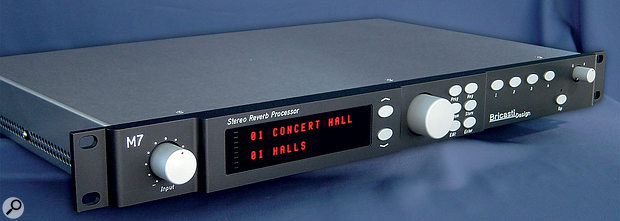 The Bricasti M7 — truly a stereo reverb to drool over! But is a stereo reverb effect always the best option in your mix?
The Bricasti M7 — truly a stereo reverb to drool over! But is a stereo reverb effect always the best option in your mix?
I'm not really sure when it's best to use mono reverb effects — and how to pan the reverb when doing so — and when to use stereo reverb. Can you de-confuse my mind a little?
Chris O'Rourke
SOS contributor Mike Senior replies: One situation where you might reach for a mono reverb is where you want to avoid cluttering the mix. The thing about stereo reverb is that it does tend to wash right across the stereo image, whether you want it to or not, even if you're sending to it from a mono track. Furthermore, if you pan a track to the left-hand side, and also send from it to a reverb, sometimes that reverb will only accept a mono input, and will therefore spread its effect evenly from left to right, regardless of the dry track's image position. So if you're fighting for clarity in a mix, you might consider making some of your reverb effects mono and panning the effect returns to match the stereo positions of the dry tracks that feed them.
A slight variation on this can be useful where you have an instrument that you want to pan off-centre, but it bugs you that there's nothing else in the arrangement to balance it out on the other side of the stereo image. In that scenario, one solution can be to feed a mono reverb from the instrument, but pan the effect return to the opposite side of the image. One advantage of doing this, as opposed to just using a stereo reverb, is that it keeps the centre of the mix clear, which can help with the clarity of centrally panned lead instruments and vocals. The other big reason you might want to use a mono reverb is that it inevitably sounds less like a natural acoustic space, so it won't pull instruments backwards into the mix as strongly. As such, mono reverb is great for enhancing the sustain or tone of a dry instrument/vocal track, without distancing it too much from the listener.
However, I think polarising the question into a 'mono versus stereo' dichotomy is actually a bit restrictive, because those are only two facets of the wider issue of stereo width in reverb effects. Yes, I use mono reverbs from time to time, but it's much more common for me to adjust the stereo width of a reverb return using Mid-Sides processing. For example, I'll frequently reduce the stereo width of a snare reverb to make it fit more convincingly within the stereo image of a full drum-kit recording. And I often widen an overall drum reverb to reduce its energy levels at the centre of the stereo panorama — particularly if I've narrowed the panning of over-wide overhead-mic recordings, thereby focusing more of the natural drum ambience into the centre of the image.
Another nifty trick for chart-targeted pop and EDM productions is to widen a reverb effect until it gives that 'outside the speakers' illusion, and then use just a small amount of it to expand the apparent width of your mix as a whole. Although such a reverb will have such dreadful mono-compatibility that it may pretty much vanish in mono, that's rarely a great loss in practice, because the reverb serves no musical function. Better to lose some reverb in mono, than an important musical line!
